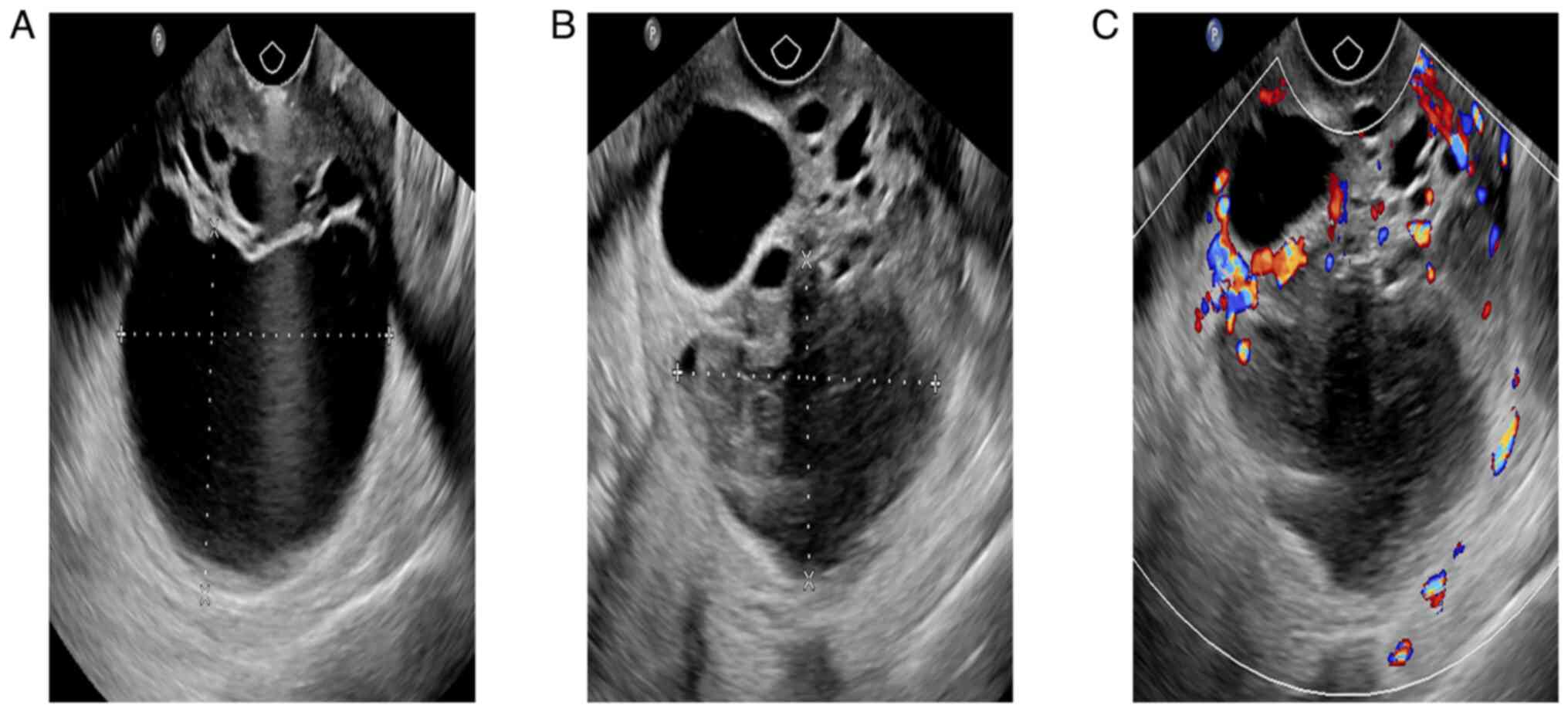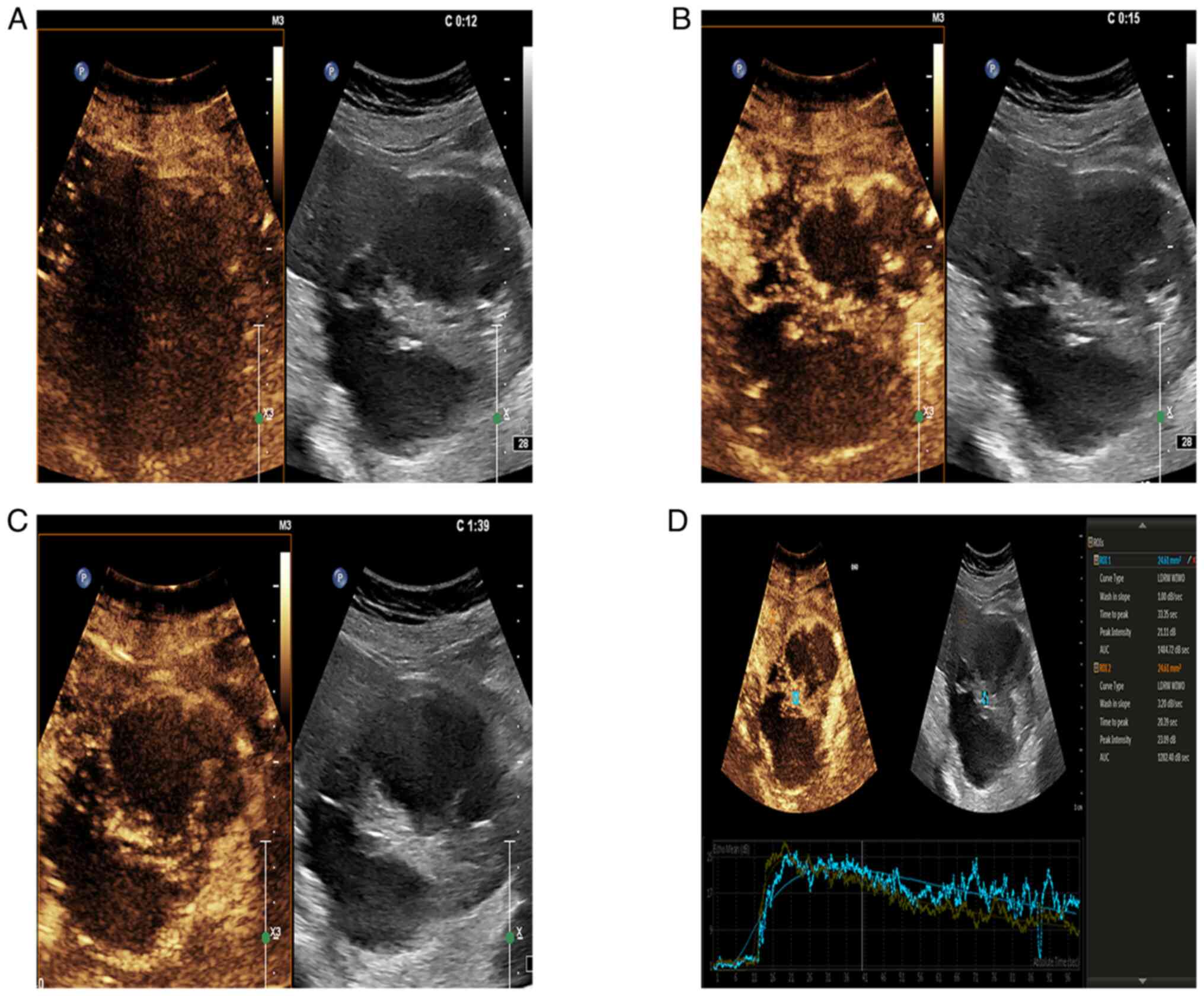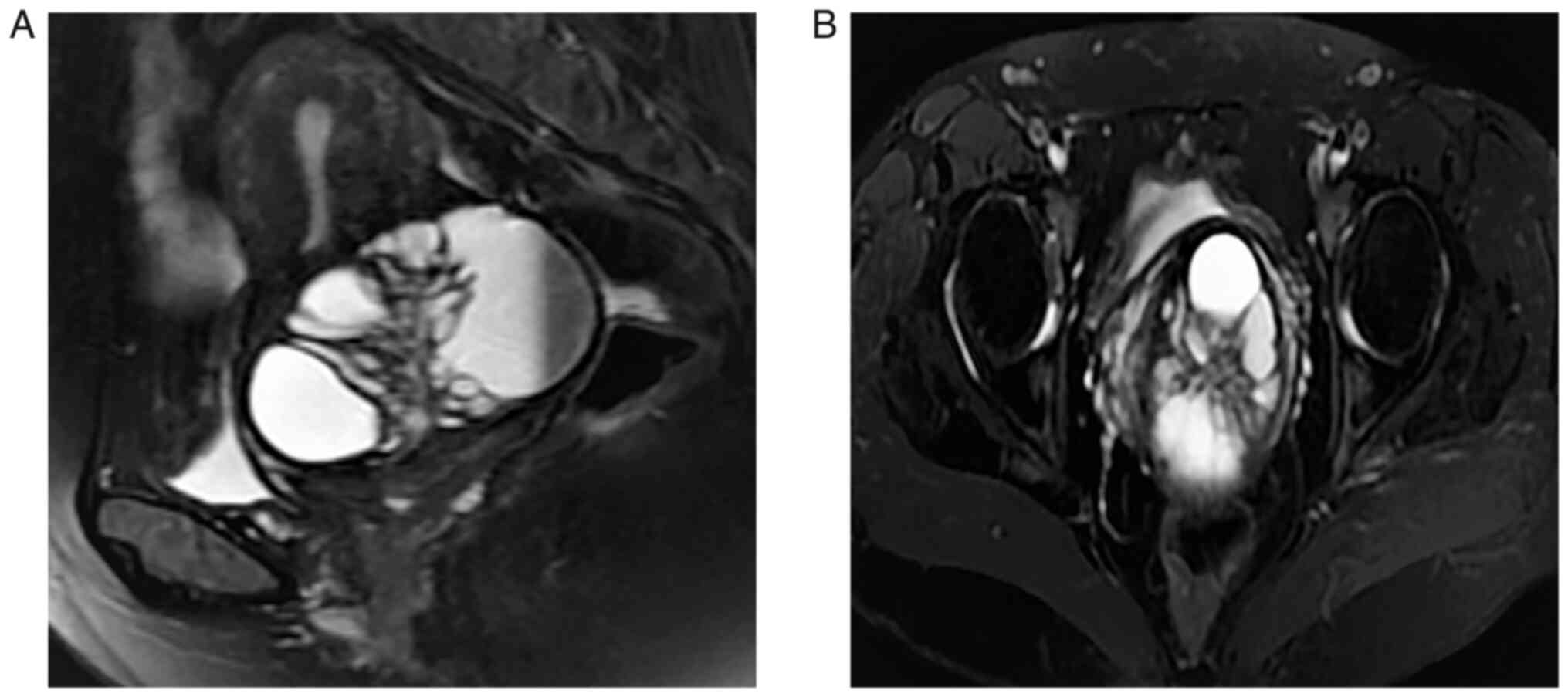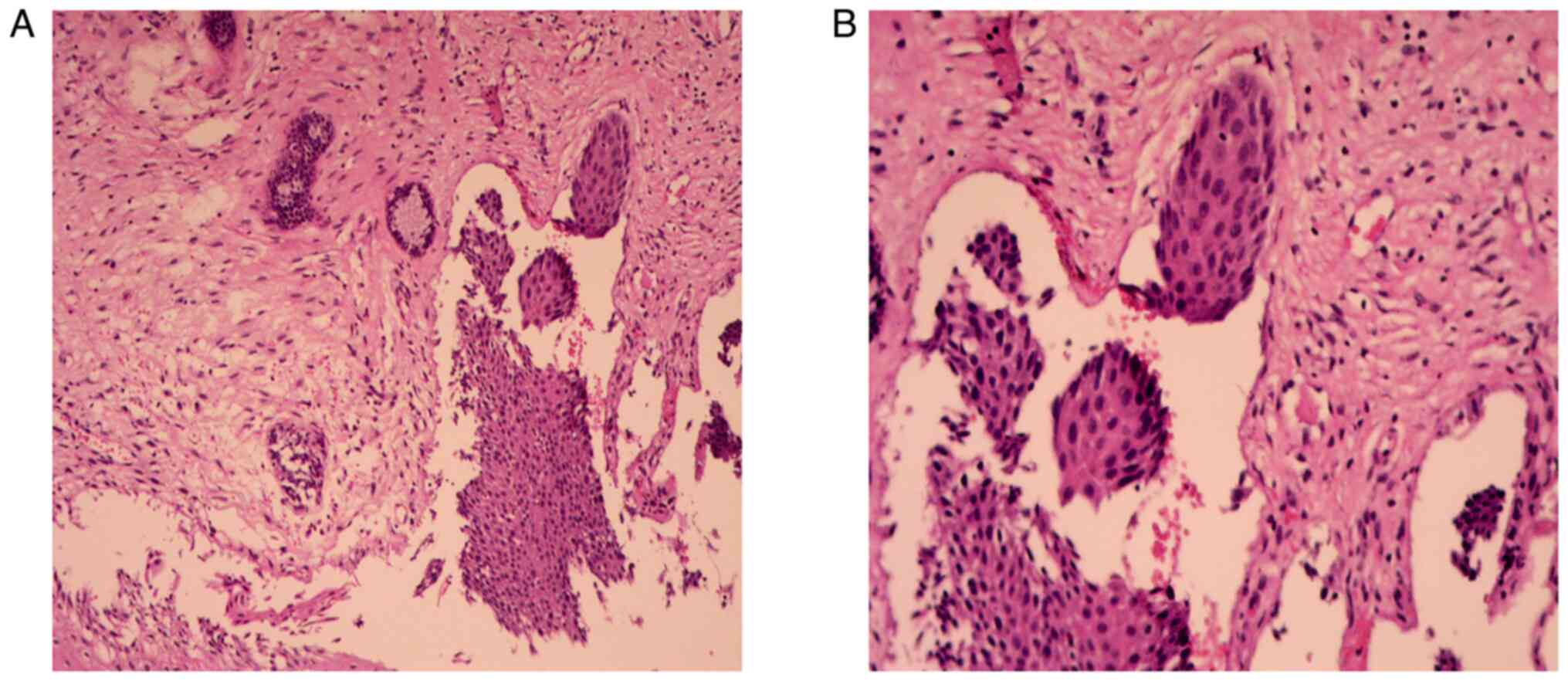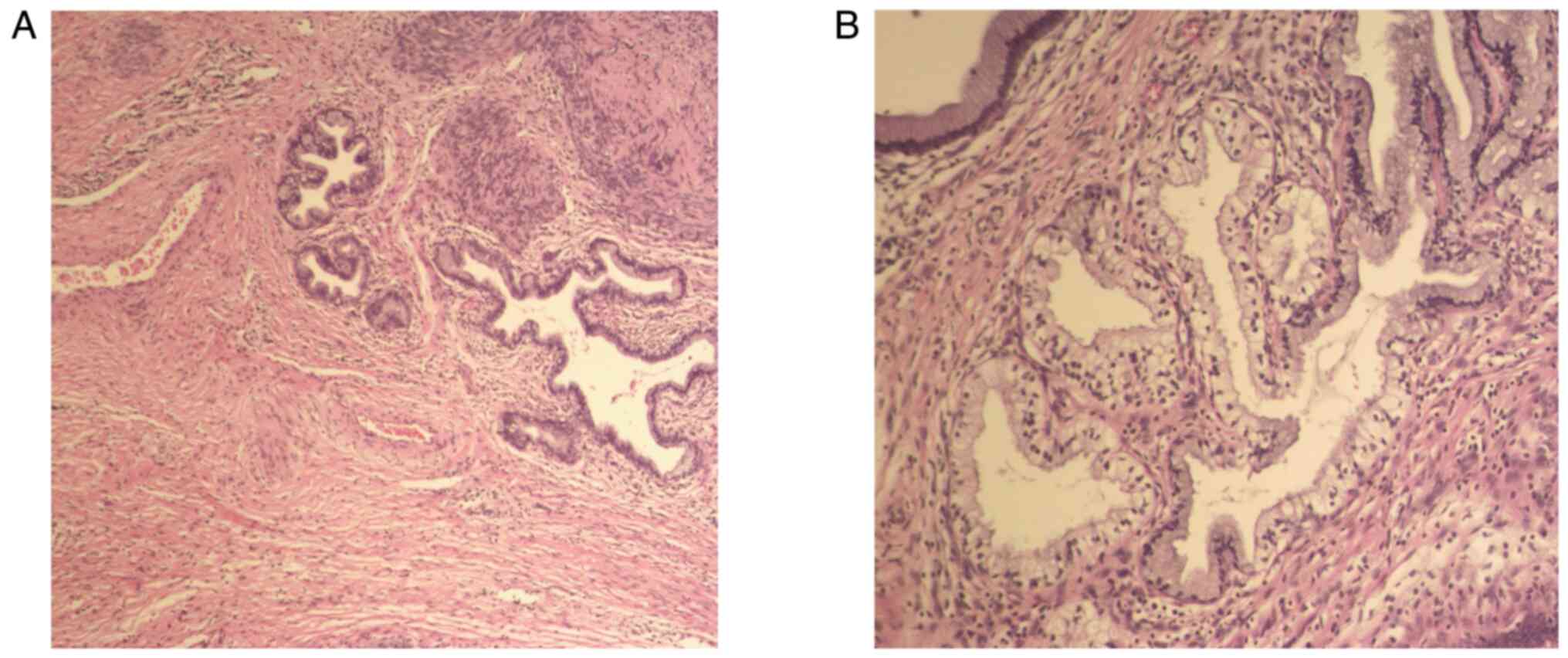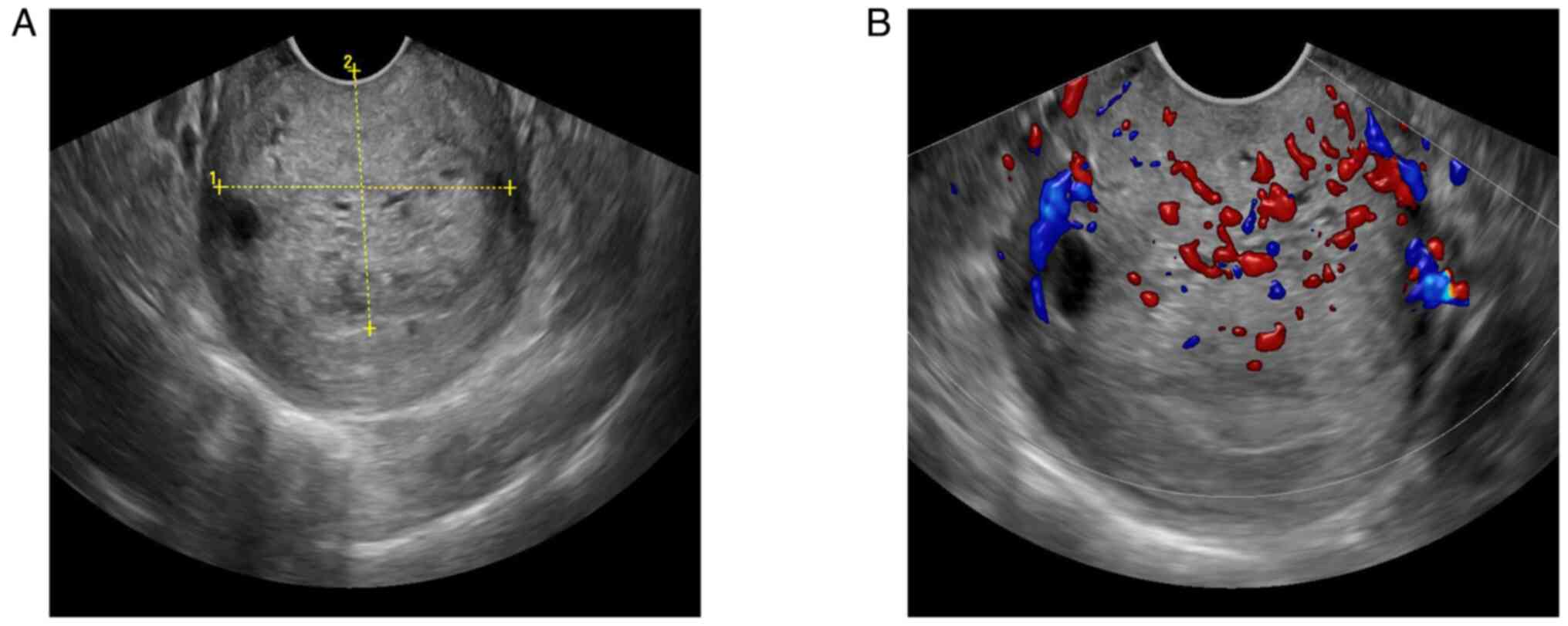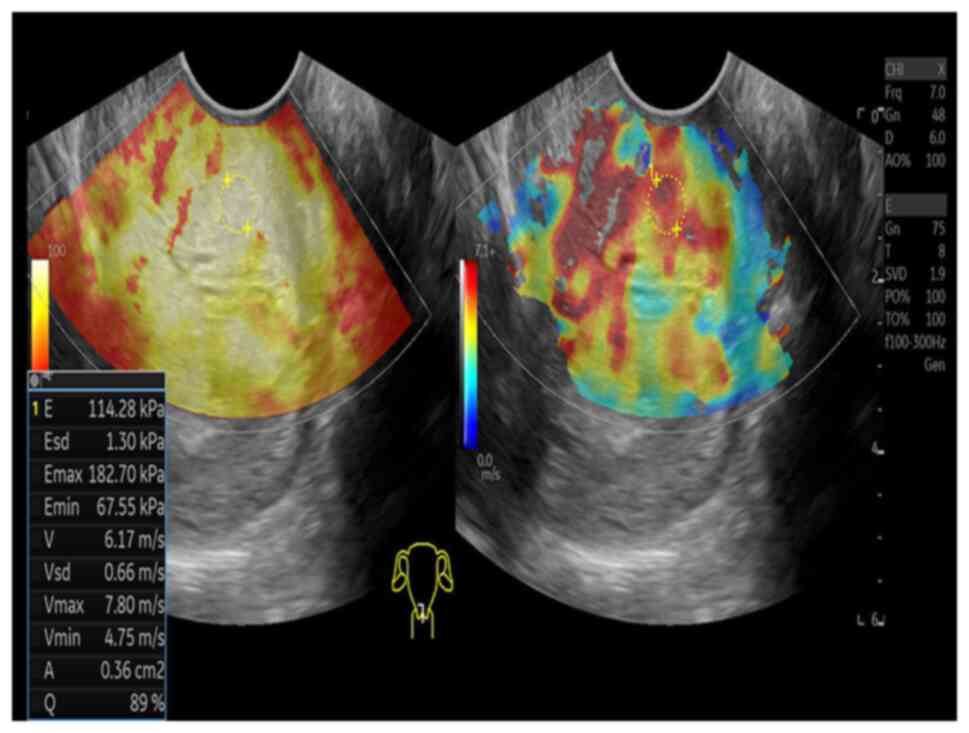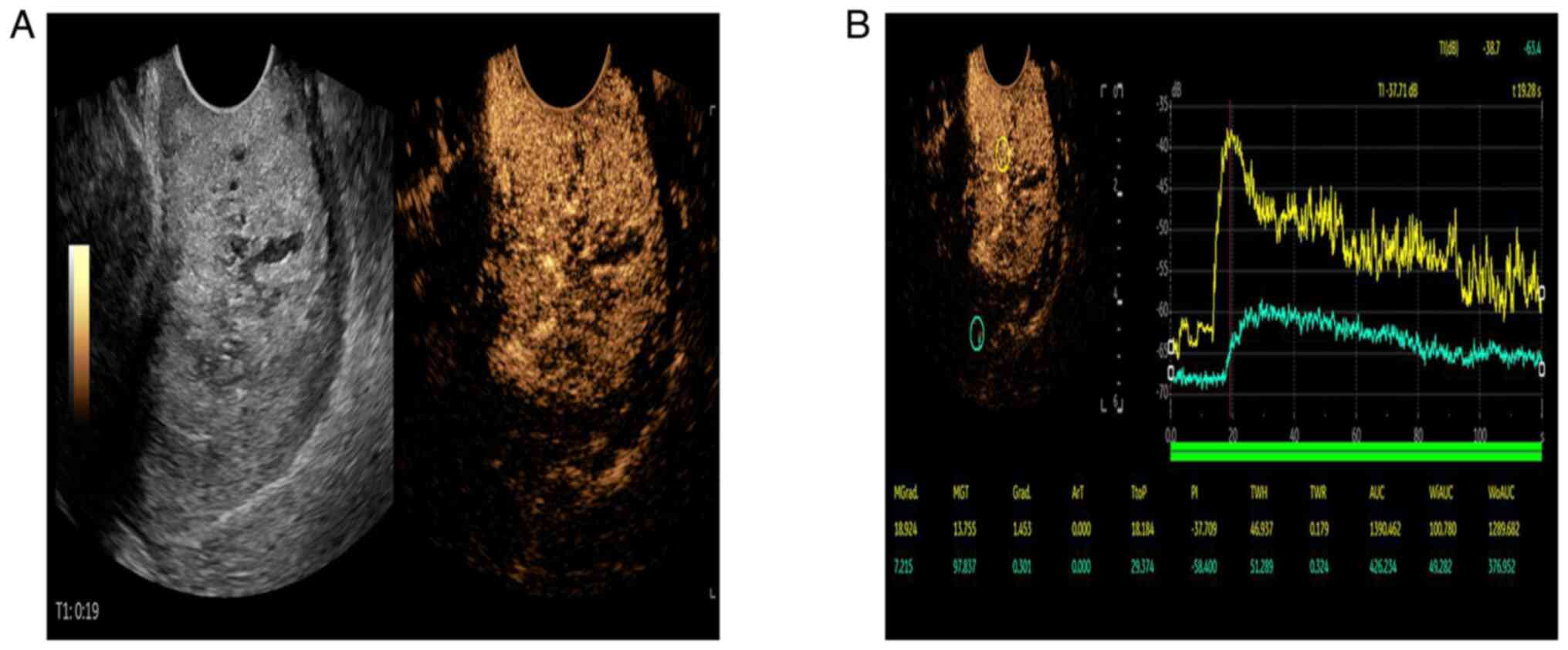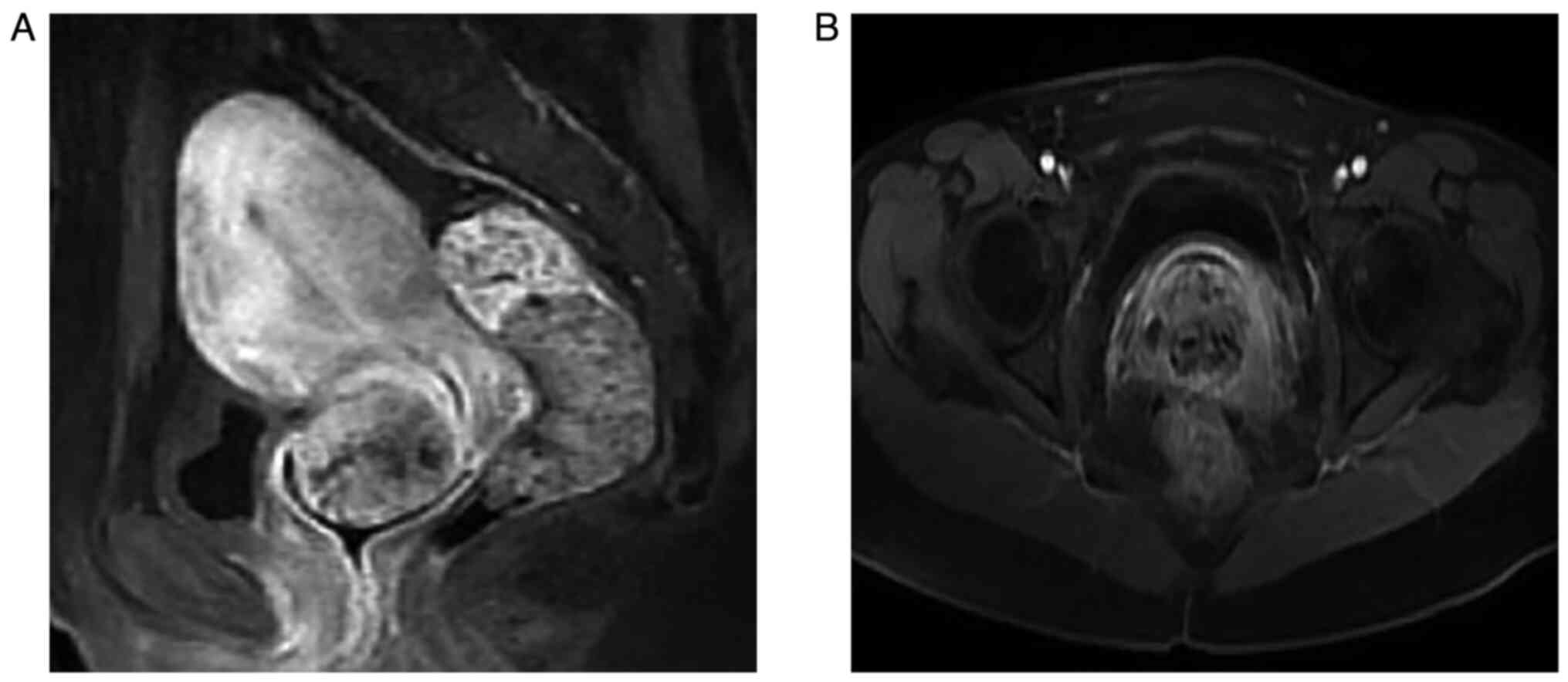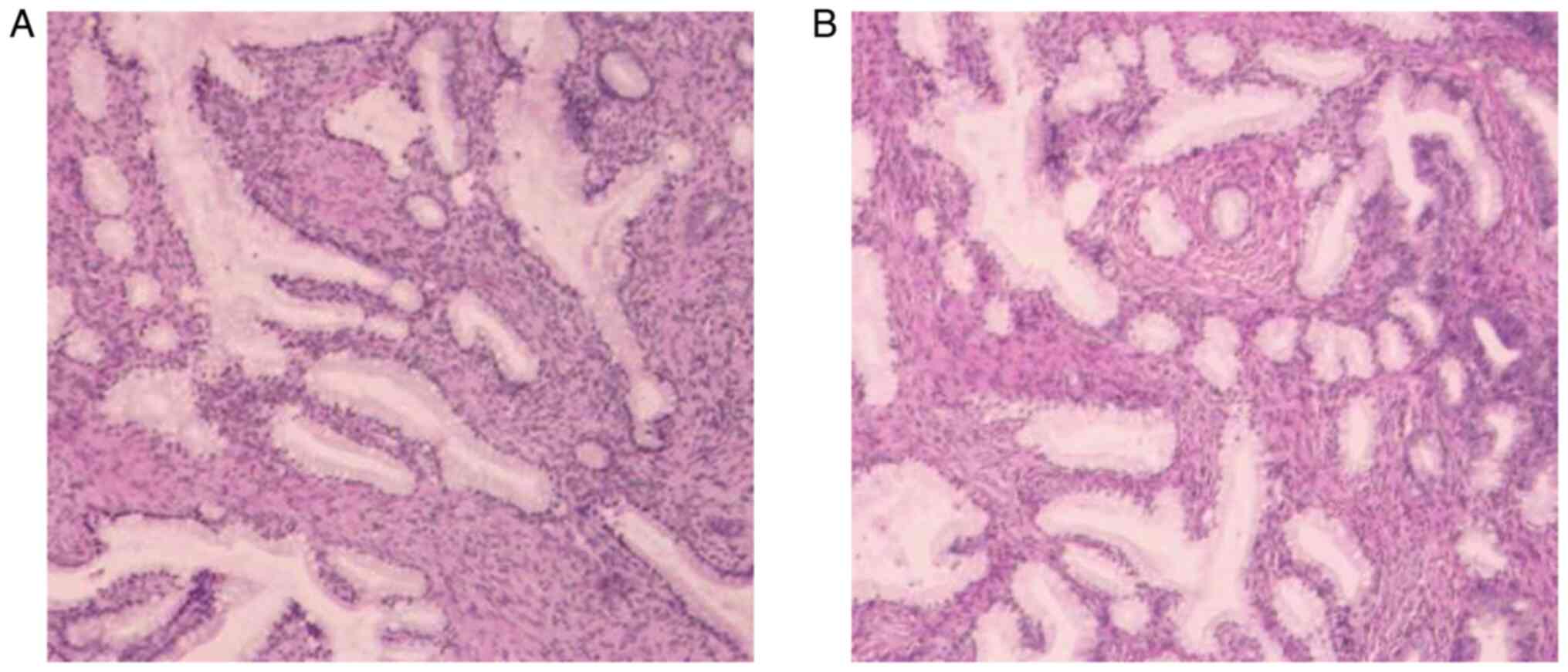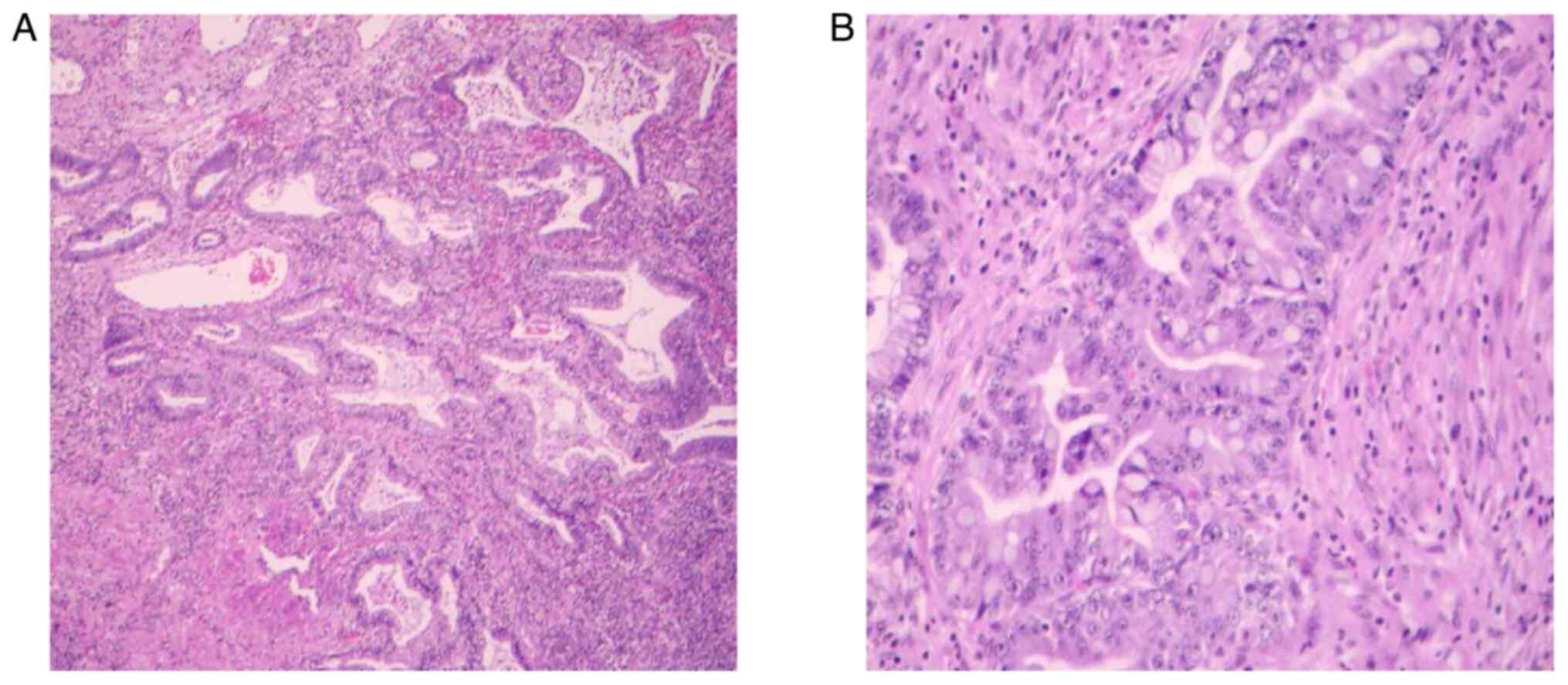Gastric‑type endocervical adenocarcinoma: A report of two cases
- Authors:
- Published online on: May 30, 2024 https://doi.org/10.3892/ol.2024.14477
- Article Number: 344
-
Copyright: © Wang et al. This is an open access article distributed under the terms of Creative Commons Attribution License.
Abstract
Introduction
Gastric-type endocervical adenocarcinoma (GEA) is a specific subtype of cervical adenocarcinoma that is not associated with human papillomavirus (HPV) and accounts for only 1–3% of cervical adenocarcinomas (1). The disease is characterized by vaginal mucin (2,3) or watery discharge (4,5), but irregular vaginal bleeding can also occur. However, these clinical manifestations lack specificity and can also be seen in other types of endocervical lesions. Due to the insidious nature of GEA and the extremely low success rate of routine screening and biopsy, a missed or delayed diagnosis, or a misdiagnosis are common problems (6–8). In addition to diagnostic difficulties, the poor prognosis of GEA is a concern. This is largely attributable to an unusual pattern of dissemination, including lymphatic spread and invasion of the parametrial space, which results in poor progression-free survival and overall survival times. In 104 patients with GEA (9), the mean survival time for patients with stage I disease was reported to be ~5 years, while stage II was ~38.1 months, stage III was ~22.8 months and stage IV was ~5.4 months. In addition, the literature states that the 5-year specific overall survival rate of GEA is only 30–42% (7). It is notable that even in stage I, the disease is often poorly differentiated (high grade) (6), is resistant to standard therapy (10) and often involves metastases to sites such as the ovaries, peritoneum or omentum. Therefore, it is important to improve the preoperative diagnosis of GEA.
Through careful analysis of the relevant literature and the cases reported in the present study, it was found that imaging examination methods have significant advantages in the diagnosis of GEA. For example, in transvaginal ultrasound (TVUS) examination, the lesion is multilocular cystic and communicates with the uterine surface to form tunnel-like changes (5,8), while in contrast-enhanced US (CEUS), a ‘fast rise and fast fall’ curve is formed (11,12), and finally, in magnetic resonance (MR) examination, a ‘cosmic-type’ image is noted, with a small cyst or solid component in the center of the lesion surrounded by a large cyst (13–15). These typical imaging findings are essential for the diagnosis and differential diagnosis of GEA. With the rapid development of science and technology, artificial intelligence (AI) has been widely used in the field of medical imaging. AI technology has made significant progress, enabling models to automatically recognize and analyze a variety of medical images, such as X-rays, computed tomography and magnetic resonance (MR) imaging scans. In particular, it has great potential in tumor detection. AI technology can identify and locate the tumor area, and provide accurate measurement results, thereby greatly improving the accuracy and efficiency of radiologists (16).
The present study describes two complete cases of GEA, and the most comprehensive and reliable imaging features of the three aforementioned imaging examinations are described in detail, which play an important role in the diagnosis of the disease. These imaging features can provide effective clues for clinicians to develop more accurate and effective treatment plans to improve the prognosis of affected patients.
Case reports
Case one
Patient A, a 46-year-old woman, presented to The Women's Hospital, School of Medicine, Zhejiang University (Hangzhou, China) in February 2021 with moderate vaginal discharge that was clear in color or occasionally yellow in color, no abdominal pain or abdominal distension, and no contact bleeding. The patient had no family history of genetic, neurological, psychiatric, infectious or similar diseases. A ThinPrep® cytological test (TCT) was performed and the patient was negative for intraepithelial lesions or malignancy (NILM), but was HPV-positive. The results of the TVUS suggested multiple cysts in the cervix. In June 2021, the vaginal fluid of the patient had been greenish-yellow and a cervical biopsy had shown chronic inflammation of the cervical mucosa with squamous cell proliferation. The diagnosis was further confirmed by TVUS (Fig. 1A-C), which suggested a multilocular cystic solid mass with irregular thickening of the cyst wall in the cervix. The fluid in some of the cysts was viscous, the solid regions were small and honeycomb-like and color Doppler showed a rich blood supply. In August 2021, the results of another TVUS showed that the cervical cysts had increased in size, and the larger cysts were ~7.5 cm in diameter. The CEUS (Fig. 2A-D) suggested that the contrast agent began to fill at 12 sec, reached a peak at 15 sec and began to weaken at 1 min and 39 sec. The solid regions showed hyperenhancement, which was indicative of cervical cancer. Contrast-enhanced MR of the pelvis (Fig. 3A and B) showed abnormal signal foci in the cervix with multiple cystic lesions, hypointensity on T1-weighted imaging (T1WI) and hyperintensity on T2WI of the cystic fluid, and moderate enhancement of the cyst wall and cyst septum, leading to the consideration of GEA. Furthermore, hydrocolpos were still observed after conization. After discussion, the decision was made to perform US-guided biopsy of the cervical mass. Postoperative pathological (Fig. 4A and B) results of the cervical mass showed smooth muscle tissue and cervical mucosa chronic inflammation. After obtaining informed consent from the patient, an abdominal extrafascial hysterectomy, bilateral salpingo-oophorectomy and intestinal adhesiolysis were performed at the Women's Hospital, School of Medicine, Zhejiang University (Hangzhou, China). Postoperative pathology (Fig. 5A and B) showed atypical hyperplasia of the cervical lobular gland with malignant transformation (well-differentiated gastric adenocarcinoma), invading more than two-thirds of the stroma, involving the isthmus intima and fibromuscular layer. The periuterine and bilateral ovarian vessels were not invaded by the tumor. The results were in accordance with International Federation of Gynecology and Obstetrics (FIGO) stage IB3 disease (17). Immunohistochemical staining results: ER (+), PR (+), CEA (+), P53 (+; wild-type) and P16 (+), Ki-67 (+ 5%), PAX2 (−), MUC-6 (+), Mucin5AC (+) and SMA (+). Alcian blue, and periodic acid Schiff staining results: (−/+). Postoperative adjuvant chemotherapy with paclitaxel and carboplatin was administered four times, once a month. After 2 months of adjuvant chemotherapy, the patient was doing well, with pelvic contrast-enhanced MR showing no obvious recurrence or metastasis. The patient has been followed up for >2 years and no recurrence has been found. This case suggests that clinical symptoms with multimodal imaging should be combined to reduce misdiagnosis or missed diagnosis.
Case two
Patient B, a 39-year-old woman, presented to The Women's Hospital, School of Medicine, Zhejiang University (Hangzhou, China) in August 2022 with increased vaginal discharge for 6 months, which was mucoid and clear in color, accompanied by frequent urination and no abnormal uterine bleeding. The patient had no family history of genetic, neurological, psychiatric, infectious or similar diseases. The results of the TCT showed that the patient was NILM and HPV-negative. The TVUS (Fig. 6A and B) showed heterogeneous echo areas in the anterior lip of the neck with clear boundaries, regular shapes, multiple cystic areas and color Doppler demonstrated a rich blood supply. The shear wave elasticity (Fig. 7) showed moderately hard texture, indicating a diagnosis of GEA. For further diagnosis, CEUS was performed and the results (Fig. 8A and B) suggested that the hypoechoic area of the anterior cervical lip began filling at 14 sec and reached the peak at 19 sec. The tumor tissue showed rapid hyperenhancement and then slowly decreased. Pelvic contrast-enhanced MR (Fig. 9A and B) suggested the presence of a leiomyoma lesion on the anterior lip of the cervix, with clear boundaries and patchy long T2 signals, which showed heterogeneous enhancement after enhanced scanning, and so cervical leiomyoma with degeneration was considered. The cervical biopsy pathology (Fig. 10A and B) was indicative of GEA. After obtaining informed consent, the patient underwent an abdominal radical hysterectomy, pelvic lymph node dissection, bilateral salpingo-oophorectomy and intestinal adhesion lysis at the Women's Hospital, School of Medicine, Zhejiang University. The postoperative pathological (Fig. 11A and B) diagnosis was GEA, which infiltrated the entire interstitial layer and involved the fornix. The tumor did not invade the periuterine, bilateral ovarian vessels and greater omental tissue. A total of 33 lymph nodes were not invaded by the tumor. The immunohistochemical staining results were: Insulin-like growth factor II m-RNA-binding protein 3 (+), D2-40 (vascular +), estrogen receptor (−), progesterone receptor (−), carcinoembryonic antigen (local +), P53 (wild-type), low molecular weight cytokeratin (+), P16 (+), Ki-67 (+ 60%), MUC-6 (+), programmed cell death protein 1 (tumor proportion score:-; combined positive score:<1) and programmed death ligand 1 (tumor proportion score:-; combined positive score:<1). The results were in accordance with FIGO stage IIA2. Preoperative examination showed that the CA199 tumor marker level of the patient was 401.9 U/ml (normal reference value, ≤37.0 U/ml) (18). At 2 months post-surgery, the CA199 tumor marker level decreased to 86.0 U/ml (normal reference value, ≤37.0 U/ml). At 8 months post-surgery, the CA199 tumor marker level had recovered to 25.4 U/ml (normal reference value, ≤37.0 U/ml). The patients were followed up every 3 months for 1–2 years post-operation, and every 6 months for 3–5 years thereafter. Currently, patient B has been followed up for nearly 2 years with no evident recurrence. The key messages in this case are the need to accurately understand the typical imaging findings of GEA and the fact that the use of a deep biopsy or conical incision for suspicious lesions is necessary.
Discussion
The most common TVUS finding of GEA is cervical hypertrophy with multiple cystic lesions (5). Park et al (8) proposed that 60% of GEA lesions were multilocular cystic, 40% were solid and 50% of cystic lesions were accompanied by solid components. The study also indicated that color Doppler showed a rich blood supply in GEA lesions, which is helpful for the diagnosis of GEA. In the present study, the two cases were similar to those observed in the literature, whereby multiple cystic dark areas were seen in the cervix, and color Doppler showed an abundant blood supply. By contrast, patient A showed irregular thickening of the cyst wall, viscous fluid in the interior and small honeycomb-like changes in the solid part of the lesion. The cystic dark area of the cervix in patient B communicated with the cervical surface to form a tunnel-like change, which was helpful for the diagnosis of GEA.
Compared with TVUS alone, the combined application of TVUS and CEUS can significantly improve the accuracy of the diagnosis of GEA. CEUS can greatly improve the sensitivity of the lesion blood vessels and their small blood flow signals (11), and make real-time dynamic observations of the capillary blood flow inside the lesion to determine its perfusion and distribution, and ultimately determine the microcirculation status inside the lesion tissue (12). Some studies (11) have proposed that the time to peak (TTP) and peak intensity (PI) of CEUS quantitative parameters have statistical significance in the differentiation of benign and malignant cervical tumors, and found that lower TTP values and higher PI values are indicators for the identification of early cervical cancer. In cervical cancer, CEUS shows rapid enhancement of focal tissue, showing a ‘sharp rise and fall’ curve (12). In the present study, in patient A, CEUS showed rapid hyperenhancement of the lesion with the results from the tumor tissues (TTP, 20.39 sec; PI, 23.09 dB) and the control tissue (TTP, 33.35 sec; PI, 21.11 dB). In patient B, CEUS showed rapid hyperenhancement of the lesion followed by slow regression with the results from the tumor tissues (TTP, 18.18 sec; PI, −37.71 dB) and control tissues (TTP, 29.37 sec; PI, −58.40 dB). The results of CEUS in patients A and B were consistent with the results of previous studies. The tumor tissues had lower TTP values and higher PI values than control tissues (11,12). This may be as the larger the lesion infiltration area, the more new blood vessels, the less smooth muscle cells and elastic fibers, and the weaker or less functional the vascular endothelial cells. As a result, the filling and fading times of the contrast agent are accelerated, resulting in decreased TTP values and increased PI values, forming a ‘fast rise and fast fall’ curve (11,12,19). The difference is that the enhanced mode of CEUS can be ‘fast in and fast out’ or ‘fast in and slow out’. To the best of our knowledge, to date, the present study is the first to apply CEUS to the diagnosis of GEA. Therefore, in the absence of direct correlation studies, lessons are drawn from the application experience of CEUS technology in other types of cervical tumors and combined with the existing GEA-related research data for speculation and analysis. This may aid the understanding and evaluation of the potential value of CEUS in GEA.
Currently, MR is the most accurate imaging examination for the diagnosis of GEA, as it can most effectively identify the parenchymal component in the cystic lesions, which is also the key to distinguish GEA from other cervical cystic lesions (20). Some scholars have found that GEA often occurs in the cervical stroma, does not form any exophytic mass in morphology, is located in the upper part of the cervical canal, often invades the uterine body, and is accompanied by multiple cystic lesions (6,21). The characteristic MR findings are multilocular cystic lesions in the deep part of the cervix, in which the solid region is composed of multiple cysts of varying sizes (20). In another study (22), patients with GEA exhibited an isohypointense signal on T1WI, a slightly hyperintense signal on T2WI, an isointense signal on diffusion-weighted imaging and heterogeneous enhancement after contrast enhancement. In a multicenter study (13–15), contrast-enhanced pelvic MR of patients with GEA showed a cervical isthmic mass with multiple small cysts and/or a solid region surrounded by large cysts. This phenomenon was termed the ‘cosmos’ mode, and this pattern was used to diagnose GEA with an accuracy of 67% (10/15 patients). The present study reported the cases of two patients. The pelvic contrast-enhanced MR images of patient A were consistent with those described in the previous literature and also showed a typical ‘cosmos’ mode. However, the images of patient B did not show this pattern, possibly due to the difference in presentation caused by the different degree of invasion of the GEA mass into the cervical stroma.
In order to improve the diagnostic accuracy of GEA, in addition to imaging methods, other screening methods must be used in combination, such as cytological examination (including TCT examination and HPV examination), colposcopy and cervical biopsy (23). However, for GEA, some studies have found that the accuracy of detecting cervical invasive adenocarcinoma based on Pap smears is only 45–76% (24,25). In the present study, the preoperative workup of patient A, including cytology, colposcopy and a biopsy by cervical conization, was negative. There are two main reasons for the negative results. One reason (26) is that GEA lesions are very deep, occur in the cervical canal, do not penetrate the cortex of the transitional zone and show a skip infiltration, which can lead to insufficient sampling of the lesion tissue. The other reason (27) is that the atypia of GEA itself is easily overlooked in smears, as its tissue is well differentiated and easily confused with benign lesions. The retrospective analysis of Papanicolaou smears of patients with invasive adenocarcinoma of the cervix, which appear negative, has found false-negative rates as high as 40–60% (25). After reviewing the literature on GEA, the Department of Pathology of the Women's Hospital, School of Medicine, Zhejiang University, re-studied the previously negative Pap smears, and finally >20 cases of GEA were diagnosed. It has also been proposed that when a patient has a large amount of vaginal watery discharge, a vaginal US examination and cytology smear should be performed. If cervical multiple cysts and yellow mucus are found in the cytology smear, a HIK1083 latex agglutination test is recommended, which can identify gastric mucosal mucin and has a very high specificity (28), which is very helpful for the diagnosis of GEA.
In conclusion, it is recommended that TVUS be performed first when a patient presents with a large amount of vaginal watery discharge. If there are multiple cystic dark areas with tunnel-like changes in the cervix, CEUS and/or pelvic enhanced MR should be further used to confirm the diagnosis. In addition, if the imaging findings are not consistent with the typical imaging findings of GEA, a biopsy or surgery is recommended to clarify the lesion type for further treatment. The present study has some limitations due to the small number of cases and limited clinical data.
Acknowledgements
Not applicable.
Funding
The present study was supported by grants from the National Natural Science Foundation of China (grant nos. 81974470 and 82272004) and the Natural Science Foundation of Zhejiang Province (grant no. LY18H180001).
Availability of data and materials
The data generated in the present study may be requested from the corresponding author.
Authors' contributions
GK and XF collected clinical data. MW analyzed the data. QW and YL analyzed and interpreted the data, and wrote the paper. GK and MW confirm the authenticity of all the raw data. JZ obtained medical images (TVUS, CEUS and MRI scans). All authors have read and approved the final manuscript.
Ethics approval and consent to participate
The present study was approved by the Institutional Ethics Committee of the Women's Hospital, School of Medicine, Zhejiang University (approval no. IRB-20230191-R).
Patient consent for publication
As this study was retrospective, the two patients who had been discharged from the hospital were contacted by telephone and provided verbal consent for publication. The requirement for written consent was waived by the Institutional Ethics Committee of the Women's Hospital, School of Medicine, Zhejiang University.
Competing interests
The authors declare that they have no competing interests.
Glossary
Abbreviations
Abbreviations:
|
GEA |
gastric-type endocervical adenocarcinoma |
|
HPV |
human papillomavirus |
|
TCT |
ThinPrep®, cytological test |
|
TVUS |
transvaginal ultrasound |
|
CEUS |
contrast-enhanced ultrasound |
|
MR |
magnetic resonance |
|
NILM |
negative for intraepithelial lesion or malignancy |
|
FIGO |
International Federation of Obstetrics and Gynecology |
References
|
McCluggage WG, Singh N and Gilks CB: Key changes to the World Health Organization (WHO) classification of female genital tumours introduced in the 5th edition (2020). Histopathology. 80:762–778. 2022. View Article : Google Scholar : PubMed/NCBI | |
|
Holl K, Nowakowski AM, Powell N, McCluggage WG, Pirog EC, Collas De Souza S, Tjalma WA, Rosenlund M, Fiander A, Castro Sánchez M, et al: Human papillomavirus prevalence and type-distribution in cervical glandular neoplasias: Results from a European multinational epidemiological study. Int J Cancer. 137:2858–2568. 2015. View Article : Google Scholar : PubMed/NCBI | |
|
Qian XQ, Wang FF, Liang Y, Chen LL and Wan XY: Gastric-type mucinous carcinoma with an abnormal increase of CA199: A case report and literature review. Front Surg. 9:9459842022. View Article : Google Scholar : PubMed/NCBI | |
|
Kerwin CM, Markese M, Moroney MR, Smith LP and Patel NU: Adenocarcinoma of the uterine cervix, gastric-type (GAS): A review of the literature focused on pathology and multimodality imaging. Abdom Radiol (NY). 48:713–723. 2023. View Article : Google Scholar : PubMed/NCBI | |
|
Talia KL and McCluggage WG: The developing spectrum of gastric-type cervical glandular lesions. Pathology. 50:122–133. 2018. View Article : Google Scholar : PubMed/NCBI | |
|
Greenland NY, Wolsky RJ, Darragh TM and Vohra P: Gastric-type endocervical adenocarcinoma and cervical cytology: Experience at a general hospital and review of the literature. Cytopathology. 32:75–83. 2021. View Article : Google Scholar : PubMed/NCBI | |
|
Nishio S, Mikami Y, Tokunaga H, Yaegashi N, Satoh T, Saito M, Okamoto A, Kasamatsu T, Miyamoto T, Shiozawa T, et al: Analysis of gastric-type mucinous carcinoma of the uterine cervix-An aggressive tumor with a poor prognosis: A multi-institutional study. Gynecol Oncol. 153:13–19. 2019. View Article : Google Scholar : PubMed/NCBI | |
|
Park SB, Lee JH, Lee YH, Song MJ, Lim KT, Hong SR and Kim JK: Adenoma malignum of the uterine cervix: Imaging features with clinicopathologic correlation. Acta Radiol. 54:113–120. 2013. View Article : Google Scholar : PubMed/NCBI | |
|
Li G, Jiang W, Gui S and Xu C: Minimal deviation adenocarcinoma of the uterine cervix. Int J Gynecol Obstet. 110:89–92. 2010. View Article : Google Scholar | |
|
McKelvey JL and Goodlin RR: Adenoma malignum of the cervix. A cancer of deceptively innocent histological pattern. Am Cancer Soc. 16:549–557. 1963. | |
|
Shi JP, Zhang DJ, Yu HY and Cui Q: Assessing Intra-Lesion Microvascular Density in Patients with Early and Mid-Late Stages of Cervical Squamous Cell Carcinoma by Time-Intensity Curve of CEUS. Chin J Ultrasound Med. 3:319–322. 2022.(In Chinese). | |
|
Huang R, Wei L and Qin WH: Analysis of the Value of Ultrasonographic Parameters and MVD for Differential Diagnosis and Prognostic Evaluation of Cervical Cancer. The Pract J Cancer. 38:39–41. 2023. | |
|
Wang J, Yang Q, Wang D, Li M and Zhang N: Case report: Gastric-Type endocervical adenocarcinoma mimicking submucosal myoma under hysteroscopy. Front Med (Lausanne). 9:8454452022. View Article : Google Scholar : PubMed/NCBI | |
|
Takatsu A, Shiozawa T, Miyamoto T, Kurosawa K, Kashima H, Yamada T, Kaku T, Mikami Y, Kiyokawa T, Tsuda H, et al: Preoperative differential diagnosis of minimal deviation adenocarcinoma and lobular endocervical glandular hyperplasia of the uterine cervix: A multicenter study of clinicopathology and magnetic resonance imaging findings. Int J Gynecol Cancer. 21:1287–1296. 2011.PubMed/NCBI | |
|
Tsuboyama T, Yamamoto K, Nakai G, Yamada T, Fujiwara S, Terai Y, Ohmichi M and Narumi Y: A case of gastric-type adenocarcinoma of the uterine cervix associated with lobular endocervical glandular hyperplasia: Radiologic-pathologic correlation. Abdom Imaging. 40:459–465. 2015. View Article : Google Scholar : PubMed/NCBI | |
|
Maniaci A, Fakhry N, Chiesa-Estomba C, Lechien JR and Lavalle S: Synergizing ChatGPT and general AI for enhanced medical diagnostic processes in head and neck imaging. Eur Arch Otorhinolaryngol. 281:3297–3298. 2024. View Article : Google Scholar : PubMed/NCBI | |
|
Bhatla N, Aoki D, Sharma DN and Sankaranarayanan R: Cancer of the cervix uteri: 2021 update. Int J Gynecol Obstet. 155 (Suppl 1):S28–S44. 2021. View Article : Google Scholar | |
|
China association of professional committee of pancreatic cancer, . China of diagnosis and treatment of pancreatic cancer comprehensive guide (2020). Chin surg. 59:81–100. 2021.(In Chinese). | |
|
Xie YD, Xu CL, Yang B and Zhang LJ: Value of time-intensity curve of contrast-enhanced ultrasound in early diagnosis of cervical cancer. J Ultrasound Clin Med. 8:626–628. 2020. | |
|
Park KJ, Kim MH, Kim JK and Cho KS: Gastric-Type adenocarcinoma of the uterine cervix: Magnetic resonance imaging features, clinical outcomes, and prognostic factors. Int J Gynecol Cancer. 28:1203–1210. 2018. View Article : Google Scholar : PubMed/NCBI | |
|
Kido A, Mikami Y, Koyama T, Kataoka M, Shitano F, Konishi I and Togashi K: Magnetic resonance appearance of gastric-type adenocarcinoma of the uterine cervix in comparison with that of usual-type endocervical adenocarcinoma: A pitfall of newly described unusual subtype of endocervical adenocarcinoma. Int J Gynecol Cancer. 24:1474–1479. 2014. View Article : Google Scholar : PubMed/NCBI | |
|
Chen YP, Ho SP, Liou WS and Chen CJ: Minimal deviation adenocarcinoma of the uterine cervix. Taiwan J Obstet Gynecol. 54:447–449. 2015. View Article : Google Scholar : PubMed/NCBI | |
|
Ren WH, Zhao XL and Zhao FH: Global guidelines for cervical cancer screening: A systematic review. Zhonghua Yi Xue Za Zhi. 101:1882–1889. 2021.(In Chinese). PubMed/NCBI | |
|
Pak SC, Martens M, Bekkers R, Crandon AJ, Land R, Nicklin JL, Perrin LC and Obermair A: Pap smear screening history of women with squamous cell carcinoma and adenocarcinoma of the cervix. Aust N Z J Obstet Gynaecol. 47:504–507. 2007. View Article : Google Scholar : PubMed/NCBI | |
|
Kondo E, Takahashi A, Usami T, Yamamoto A, Nomura H, Matoda M, Okamoto S, Omatsu K, Sugiyama Y and Takeshima N: An analysis of Papanicolaou smear before treatment for adenocarcinoma in situ of the uterine cervix in 65 cases. J Jpn Soc Clin Cytol. 54:114–118. 2015. View Article : Google Scholar | |
|
Wada T, Ohishi Y, Kaku T, Aman M, Imamura H, Yasutake N, Sonoda K, Kato K and Oda Y: Endocervical adenocarcinoma with morphologic features of both usual and gastric types: Clinicopathologic and immunohistochemical analyses and High-risk HPV detection by in situ hybridization. Am J Surg Pathol. 41:696–705. 2017. View Article : Google Scholar : PubMed/NCBI | |
|
Stolnicu S, Hoang L, Chiu D, Hanko-Bauer O, Terinte C, Pesci A, Aviel-Ronen S, Kiyokawa T, Alvarado-Cabrero I, Oliva E, et al: Clinical Outcomes of HPV-associated and unassociated endocervical adenocarcinomas categorized by the International endocervical adenocarcinoma criteria and classification (IECC). Am J Surg Pathol. 43:466–474. 2019. View Article : Google Scholar : PubMed/NCBI | |
|
D'Alessandro P, Giudicepietro A, Della Corte L, Arduino B, Saccone G, Iacobelli A, Insabato L and Zullo F: A case of gastric-type mucinous endocervical adenocarcinoma in presence of nabothian cysts. Eur J Obstet Gynecol Reprod Biol. 236:254–255. 2019. View Article : Google Scholar : PubMed/NCBI |



